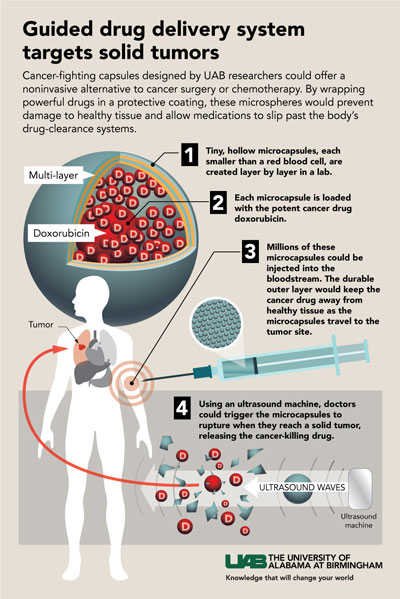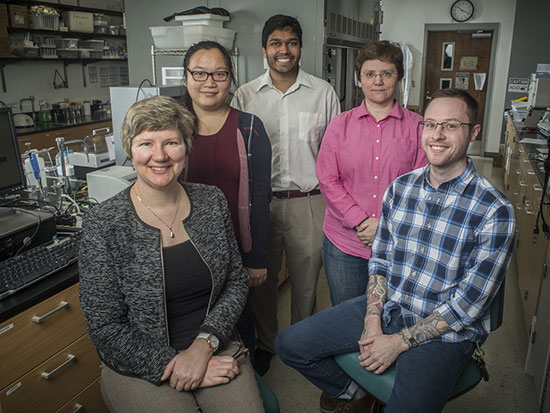 These multilayer capsules show three traits that have been difficult to achieve in a single entity. They have good imaging contrast that allows detection with
These multilayer capsules show three traits that have been difficult to achieve in a single entity. They have good imaging contrast that allows detection with
These three features create a guided drug delivery system to target solid tumors. Therapeutic efficacy can be further improved through surface modifications to boost targeting capabilities. Diagnostic
This precise control of when and where doxorubicin or other cancer drugs are released could offer a noninvasive alternative to cancer surgery or systemic chemotherapy, the UAB researchers report in the journal ACS Nano, which has an impact factor of 13.3.
«We envision an entirely different approach to treating solid human tumors of numerous pathologic subtypes, including common metastatic malignancies such as breast, melanoma, colon, prostate and lung, utilizing these capsules as a delivery platform," said Eugenia Kharlampieva, Ph. D., an associate professor in the Department of Chemistry, UAB College of Arts and Sciences. «These capsules can protect encapsulated therapeutics from degradation or clearance prior to reaching the target and have ultrasound contrast as a means of visualizing the drug release. They can release their encapsulated drug cargo in specific locations via externally applied ultrasound exposure.»
Kharlampieva — who creates her novel «smart» particles while working at the intersection of polymer chemistry, nanotechnology and biomedical science — says there is an urgent, and so far unmet, need for such an easily fabricated, guided drug delivery system.
The UAB researchers, led by Kharlampieva and
By varying the number of layers, the molecular weight of PVPON or the ratio of shell thickness to capsule diameter, the researchers were able to alter the physical traits of the capsules and their sensitivity to diagnostic ultrasound, at power levels below the FDA maximum for clinical imaging and diagnosis.
For example,
To test the ultrasound imaging contrast of the microcapsules, the UAB researchers made capsules that were 5 micrometers wide, or about two times wider than the capsules used in the rupture experiments. This size is small enough to still pass through capillaries in the lung, while a larger size for various microparticles is known to greatly improve ultrasound contrast. Red blood cells, for a size comparison, have a diameter of about 6 to 8 micrometers.

Researchers found that
A therapeutic dose of ultrasound was able to rupture 50 percent of the
Thus, Kharlampieva says, these TA/PVPON capsules have strong potential as «theranostic» agents for efficient cancer therapy in conjunction with ultrasound. The term theranostic refers to nanoparticles or microcapsules that can double as diagnostic imaging agents and as therapeutic
The next important preclinical step, Kharlampieva says, in collaboration with Mark Bolding, Ph. D., assistant professor in the UAB Department of Radiology, and Jason Warram, Ph. D., assistant professor in the UAB Department of Otolaryngology, will be studies in animal models to explore how long the UAB capsules persist in blood circulation and where they distribute in the body.
Besides Kharlampieva, Chen and Ratnayaka,


